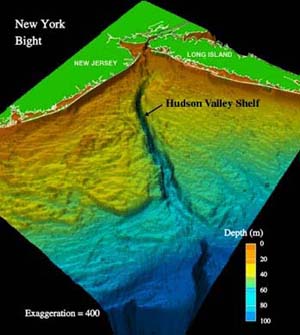
The New York/New Jersey Bight is the geological identification applied to a roughly triangular indentation, regarded as a bight, along the Atlantic coast of the United States that extends northeasterly from Cape May Inlet in New Jersey to Montauk Point on the eastern tip of Long Island. As the result of direct contact with the Gulf Stream along the coast of North America, the coastal climate of the bight area is temperate.
Geography
Further information: Geography of New York–New Jersey Harbor EstuaryThe bight is formed by the roughly right-angled intersection of the generally north-south Atlantic coast of New Jersey and the approximately east–west southern coast of Long Island at the mouth of the Hudson River. The New York Bight Apex is the area including and between the Hudson River estuary and the Raritan River estuary extending 6–7 km from the coast, and it includes both the Raritan Bay and the Lower Bay.
Weather
The geography of the bight has long been of major concern to meteorologists in the study of tropical storm patterns along the eastern coast of North America. These geographical characteristics of the area are among the primary reasons that, despite its northerly latitude, the New York Metropolitan Area is considered a high danger zone for storm-generated ocean-water surges. Specifically, in the presence of a hurricane off the coast of New Jersey, the easterly cyclonic winds along the northern edge of the storm could drive a strong surge to the west, laterally along the southern coast of Long Island and straight into Lower New York Bay. The angular bend of the New Jersey coast would leave little outlet for the surge, leading to widespread flooding throughout New York City, especially along the southern coast of Staten Island and Manhattan.
Examples of the effects of this phenomenon are the 1893 New York hurricane, in which storm surges of up to 30 feet (9.1 m) were reported, and Hurricane Sandy in 2012.
Geology
The sea floor of the New York Bight consists largely of continental shelf. It includes the offshore Hudson Canyon, an undersea Pleistocene submarine canyon that was formed by the Hudson River during the ice ages, when the sea levels were lower.
The bight includes major shipping channels that access New York Harbor.
Wind power
The Bureau of Ocean Energy Management (BOEM) is a federal agency responsible for determining offshore areas where wind farms may be built on the Outer Continental Shelf.
In March 2021, reports appeared that the Biden administration is considering giving priority designation for offshore wind projects to the New York Bight.
BOEM sells leases to qualified bidders. The waters in New Jersey and New York have been leased to private concerns for the development of US offshore wind farms. The first lease auctions were held in February 2022 for 5.6 gigawatts of power capacity and annual energy production of 19.6 TWh, for a total of $4.37 billion, with one area going for over one billion dollars.
See also
References
- "U.S. Geological Survey Studies in the New York Bight". U.S. Geological Survey. Retrieved August 19, 2011.
- Kennish, Michael J. (1997). Pollution impacts on marine biotic communities. CRC Press. p. 103. ISBN 0-8493-8428-1.
- Larson, Erik (September 25, 1999). "Hurricanes on the Hudson". The New York Times.
- Naparstek, Aaron (July 27, 2005). "The Big One: Experts say it's only a matter of time before a major hurricane". New York Press.
- Davis, Richard; FitzGerald, Duncan (2004). Beaches and coasts. Wiley-Blackwell. p. 96. ISBN 0-632-04308-3.
- Nittrouer, Charles A. (1981). Sedimentary dynamics of continental shelves. Elsevier Science. pp. 399–427. ISBN 0-444-41962-4.
- "State Activities". boem.gov. Retrieved 20 May 2015.
- Friedman, Lisa; Plumer, Brad (2021-03-29). "The Biden administration makes a swath of ocean between New York and New Jersey an offshore wind zone". The New York Times. ISSN 0362-4331. Retrieved 2021-12-27.
- Cardwell, Diane (2015-01-30). "Offshore Wind Farm Leases Draw Few Bids From Wary Industry". The New York Times. ISSN 0362-4331. Retrieved 2021-12-27.
- "New Jersey Activities". www.boem.gov. Bureau of Ocean Energy Management. Retrieved 2021-12-27.
- Morton, Joseph (2022-01-12). "Administration announces record offshore wind sale". Roll Call. Retrieved 2022-01-13.
- "New York Bight | Bureau of Ocean Energy Management". www.boem.gov. Retrieved 2022-01-13.
- Foxwell, David (26 February 2022). "US offshore wind auction blows oil and gas lease sales out of the water". Riviera.
- Lewis, Michelle (25 February 2022). "US offshore wind auction for NY Bight is final, attracts a record $4.37B in bids". Electrek. Archived from the original on 26 February 2022.
40°05′42″N 73°14′55″W / 40.094882°N 73.248596°W / 40.094882; -73.248596
Categories: